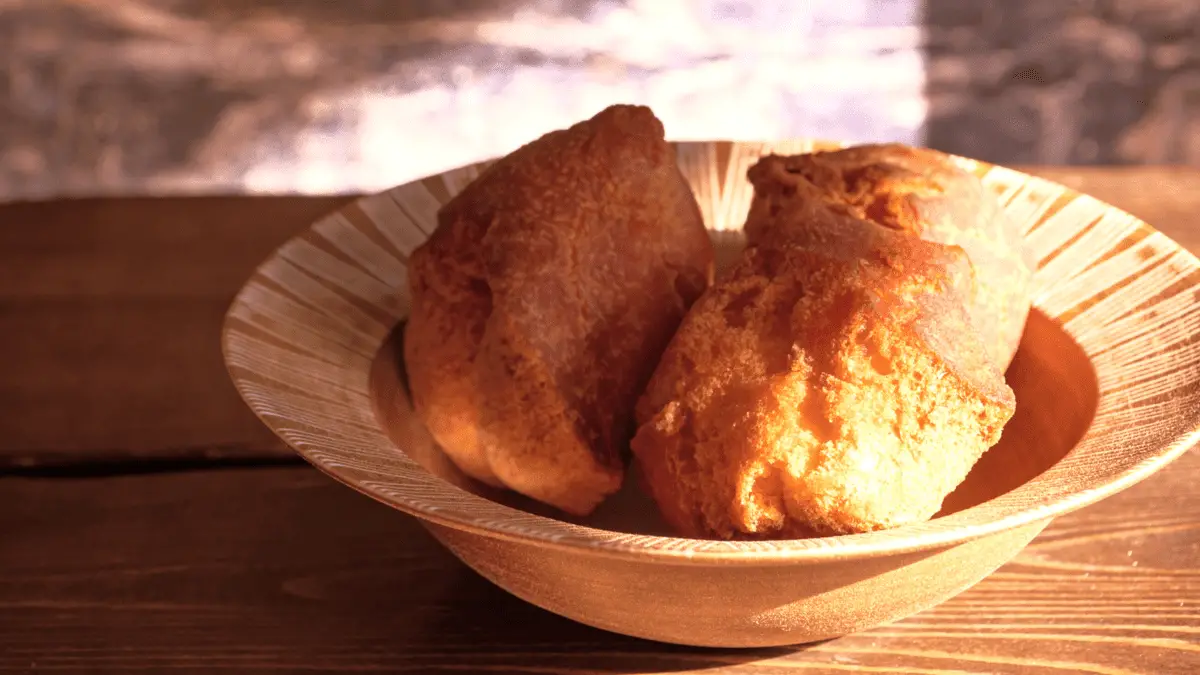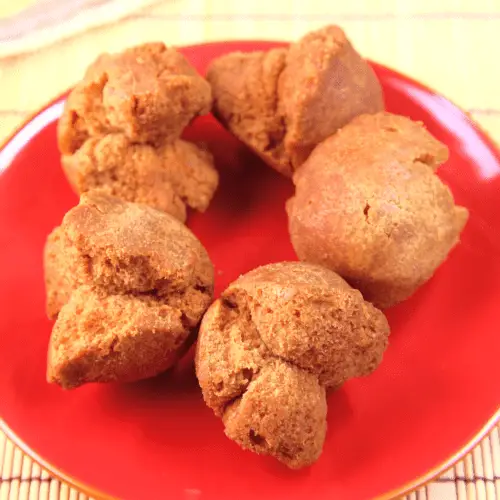Andagi recipe | All the tricks to make your own Okinawan doughnuts
If you like Japanese deep-fried foods but want to try something sweet, Okinawa’s famous sata andagi are the doughnuts to go for.
Andagi is different from the classic hole-in-the-middle Western doughnut in both appearance and flavor. These small, round cakes are more like ball-shaped fritters.
There’s something about the crunchy golden brown exterior and that fluffy cakey interior that’s just so addictive. The fresher the andagi the better so be sure to bite into it while it’s still hot.

The reason why Japan really loves this snack is that it’s so easy to make. All you need is sugar, flour, and eggs. The dough is then deep-fried to perfection and you have yourself a delicious treat!
I’m sharing an easy-to-make andagi recipe with you plus I’ll add in some vanilla which is the secret to giving the andagi that sweet, cake dough flavor.

In this post we'll cover:
Deliciously sweet Japanese andagi balls recipe
Equipment
- Wok or deep fryer
Ingredients
- 1 cup sugar
- 2 cups all-purpose flour or cake flour
- 3 eggs beaten
- 2 tsp baking powder
- 1 teaspoon vanilla extract
- 1/2 cup evaporated milk
- dash of salt
- 1-2 cups vegetable oil for frying
Instructions
- Heat a wok or pot on medium heat and add the vegetable oil. Alternatively, you can use a deep-fryer.
- While you heat oil, grab a large bowl and mix the flour, sugar, baking powder, and dash of salt. Stir and combine. (You can sift the flour but it's not necessary). Keep some suger aside for the last step.
- In a separate bowl, whisk the eggs. Add in the evaporated milk slowly, add a tiny bit of vegetable oil, and vanilla extract and mix well.
- Pour the wet ingredients over the dry flour mixture and combine gently. The egg mixture needs to be combined with the dry ingredients slowly to prevent hardening. Make sure that you don't over mix because the dough can become too hard.
- Once the cooking oil is at a deep-frying temperature of 325 F, you can begin frying the dough balls.
- Use a cookie dough scoop or your hands to form ping pong or golf-sized dough balls. You can squeeze the dough between your fingers so it comes out - it might have a small 'tail' when dropped in the oil but don't worry that crunchy bit is super delicious. When you drop the dough into the oil, it should sink a little and then rise to the surface.
- Fry the balls for approximately 8 minutes until they turn golden brown, flipping halfway. The dough rises as it cooks. You can use a toothpick to poke a hole and see if the inside is well cooked through. When viewed from all angles, the andagi appears to have opened up like a flower (tail) - this means it's done.
- Once cooked, remove the andagi and drain the oil on a paper towel or special cooling rack. Next, roll the balls in sugar before serving. Enjoy!
If you love baking sweets, you need to have an excellent cooling rack; it will make your life easier (and tastier!)
Andagi cooking tips
Let me give you some kitchen secrets on how to get your andagi fried beignets just right.
Dough consistency
Don’t overmix the dough. The dough is not supposed to be like bread dough. Instead, it should have the consistency of play-doh.
When you beat eggs and combine with the rest of the wet ingredients, always mix slowly.
Then, when you combine it with the dry ingredients, mix gently. It’s best to use a large bowl, so you have plenty of space to work in the ingredients.
Shaping the dough
You might be wondering how to form the andagi out of the dough.
Hand-forming the andagi is a simple process. Your hands should be slightly wet so that the dough does not stick to them.
Use the thumb and index finger to squeeze the dough between them until it comes out.
Toss it in, or cut it off with an opposite-finger flick or swivel.
When putting the andagi in the oil, a small tail may form at the bottom. The tail end is actually sought after by many people because it’s very crunchy.
This process of making andagi with your fingers is referred to as ‘dropping the andagi dough’.
Check how it’s done here, to give you an idea:
But, you can always use a cookie dough scooper if you don’t feel comfortable making andagi by hand. It will make the andagi look like the ones from the food stall.
Drain excess oil
It’s best to drain the extra oil with paper towels because otherwise the andagi tastes too greasy and this takes away from the perfect crunchy texture.
Substitutions and variations
You can use brown sugar instead of white sugar, or substitute it with honey. If you want your andagi to have a denser texture, add 1/4 cup of mochiko flour to the cake flour or all-purpose flour.
Mochiko flour is a type of glutinous rice flour, also called sweet rice flour, and is used to make the famous Japanese mochi.
There is nothing quite like it, but I’ve listed some of the best substitutes for sweet rice flour here in case you have a hard time finding it.
Some people don’t add baking powder but if you do, the andagi will rise and have a fluffier texture which makes it taste very good.
And if you’re feeling adventurous, try adding some chocolate chips, cocoa powder, matcha powder, or sesame seeds into the dough!
After frying, you can add some cinnamon to the sugar before rolling the balls through the mixture. The earthy flavor of cinnamon matches perfectly with the vanilla in the dough.
Westerners also like to add some toppings to the andagi such as chocolate, cream, or strawberry sauce.
But in Japan, andagi is usually eaten as it is. The simple taste of the sugar and flour dough with a hint of vanilla is more than enough to satisfy your sweet tooth.

Check out our new cookbook
Bitemybun's family recipes with complete meal planner and recipe guide.
Try it out for free with Kindle Unlimited:
Read for freeWhat is andagi?
Andagi (or sata andagi) is a type of sweet deep-fried Okinawan doughnut.
The Japanese word “saataa” means sugar, while “anda” is the word for oil. “Agii” means fried.
It has a crispy exterior with a “cracked” pattern and a soft and fluffy texture inside, similar to cake dough. It’s a popular street food dessert people of all ages enjoy.
An andagi doughnut is generally round, and about the size of a tangerine or ping pong ball.
These doughnuts are popular at Okinawan festivals but you can also buy them from food stalls year-round, not just during celebrations.
Oh, and if you’re ever in Hawaii, you can find them there too since these deep-fried snacks migrated over a long time ago.
Here’s how they make Andagi in Okinawa:
Origin & history
The andagi we know today originated from Okinawa, in northern Japan, where it’s popular street food.
Andagi is believed to have come from China to Okinawa in the 12th century. The dish is based on Chinese sweet bread. Japanese people then turned to deep frying sata andagi.
It then became popular in Hawaii because Japanese immigrants brought the recipe over when they migrated there in the late 19th century to work on sugar plantations.
So, if you’re ever in Hawaii and see andagi on the menu, don’t be surprised! There are Japanese as well as Hawaiian recipes for andagi and they’re very similar.
Did you know that sweet teriyaki sauce also has it’s origins in Hawaii?
How to serve and eat
There’s no doubt that the best way to eat andagi is when it’s fresh.
Fresh andagi is by far the most flavorful because of its crunchy texture. The andagi is crunchy on the outside and warm in the middle when it’s just out of the pan.
You can find andagi at Okinawan festivals or food stalls that sell it all year round.
When you buy andagi, they will be warm since they are deep-fried to order.
There are usually around 6-7 andagi in a box. Use your hands to eat the andagi balls or use a skewer.
You can serve them as is or with a cup of coffee or tea.
Similar dishes
There’s another exciting Japanese dish made from the exact same dough called andadogs – it’s like a corndog except the skewered hot dog is covered in this fluffy andagi dough.
Another Japanese dough snack is called dango, it’s made from rice flour and often served on a skewer with different sweet sauces.
Other Asian dishes that are similar to andagi include:
- Chinese yútiáo: a long and thin fried doughnut, often eaten for breakfast with soy milk
- Indonesian kue ape: a fried doughnut-like snack, coated with granulated sugar
- Malaysian kuih keria: a boiled then deep-fried doughnut, coated with palm sugar syrup
- Filipino turon: a banana wrapped in spring roll pastry, then deep-fried
Love these round little snacks? I explain why so many Asian foods are ball-shaped here (you’ll be surprised!)
FAQs
How long does Andagi last?
Andagi lasts for about 2 days. After that, it’s not as crunchy as when it was freshly made.
Once the andagi loses its crunchiness, it begins to taste “oily,” but it can be stored for longer.
You can also freeze the andagi and heat it up in a toaster oven.
Can andagi be reheated?
Yes, you can reheat andagi. Just heat it up in the oven at 350 F for 5-7 minutes or in the microwave for 15-20 seconds.
What is the best way to store andagi?
To store andagi, you can keep it in an airtight container at room temperature for 2 days or in the fridge for up to 1 week.
If you want to keep it longer, you can freeze it for up to 2 months.
What type of cooking oil is best to make andagi?
The best cooking oil for andagi is a type of vegetable oil, corn oil, canola oil, or peanut oil. These oils have mild flavor and they make the andagi taste good when fried.
You want to use an oil with a high smoke point so it doesn’t burn when you’re deep-frying the andagi.
How hot does oil have to be for frying andagi?
The oil should be between 325-335 F. At this temperature, the andagi gets that perfect crispy exterior and soft center.
If the oil is too hot, the andagi will cook too quickly on the outside and the inside will be doughy.
If the oil is not hot enough, the andagi will absorb too much oil and it will be greasy.
Takeaway
Now that you’ve seen how easy it is to make sata andagi Okinawan doughnuts, you can make these snacks for the family every time you crave something sweet.
The delicious crispy texture of these fried Okinawan doughnuts will have you wanting more. Even though sata andagi is made with simple ingredients, these treats are filling and sweet.
If you’re just getting into Japanese cooking, this is one of the best beginner-friendly desserts.
Ready for a more tricky cooking challenge? Try making Imagawayaki (obanyaki) recipe! A delicious Japanese dessert
Check out our new cookbook
Bitemybun's family recipes with complete meal planner and recipe guide.
Try it out for free with Kindle Unlimited:
Read for freeJoost Nusselder, the founder of Bite My Bun is a content marketer, dad and loves trying out new food with Japanese food at the heart of his passion, and together with his team he's been creating in-depth blog articles since 2016 to help loyal readers with recipes and cooking tips.
